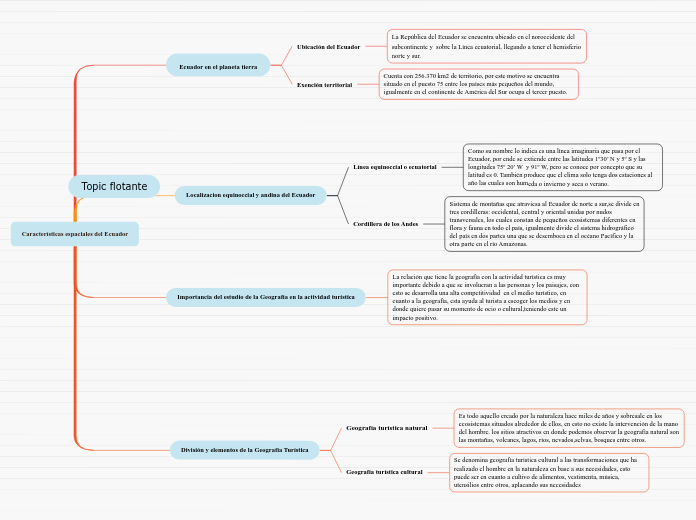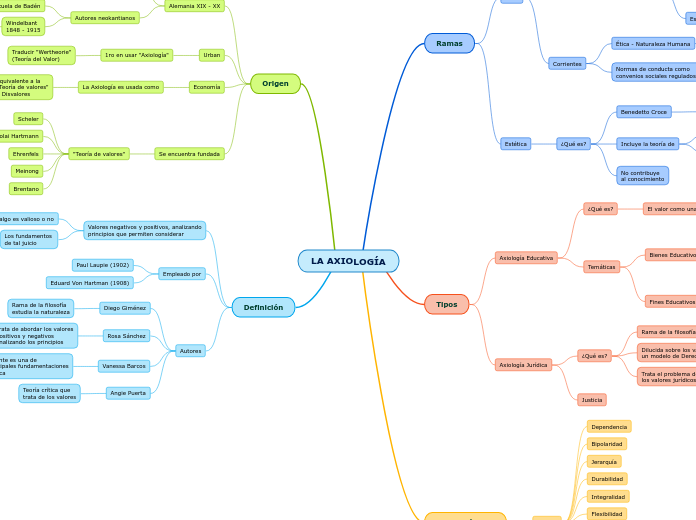Topic flotante
Características espaciales del Ecuador
To name your story, you have to think about the overall message and what you want your audience to understand from the story. Also, make it relevant and easy to remember.
División y elementos de la Geografía Turística
The ending of a story is essential. We all know that if the ending is weak, what happened before loses its importance. So make it unpredictable, but fair. A resolved ending answers all the questions and ties up any loose threads from the plot.
Geografía turística cultural
This is the closure section of the story.
See examples of possible outcomes below:
- all problems have been solved
- it's clear how each one of your characters ends up
- your main character is transformed by the challenge
Se denomina geografía turística cultural a las transformaciones que ha realizado el hombre en la naturaleza en base a sus necesidades, esto puede ser en cuanto a cultivo de alimentos, vestimenta, música, utensilios entre otros, aplacando sus necesidades
Try answering these questions to come up with a closure:
- Have all the problems been solved?
- Is there a clear picture of what happens with each character in the story?
- Has the challenge transformed your main character?
- How do the characters feel in the end?
Geografía turística natural
This is the moment when the main character surpasses the last obstacle and finally faces their greatest challenge.
The climax usually follows one of these patterns:
- realization
- resolution
- choice
Type in your answer.
Es todo aquello creado por la naturaleza hace miles de años y sobresale en los ecosistemas situados alrededor de ellos, en esto no existe la intervención de la mano del hombre. los sitios atractivos en donde podemos observar la geografía natural son las montañas, volcanes, lagos, ríos, nevados,selvas, bosques entre otros.
Importancia del estudio de la Geografía en la actividad turística
The middle of the story is where you add layers of complications that will lead to the end. Reveal more about the character's journey. Did their personality go through changes? How did they overcome the challenges? And as you build up the story’s central conflict, make it more personal to that character. Also, from the middle act, you have to lead into the final act.
La relación que tiene la geografía con la actividad turística es muy importante debido a que se involucran a las personas y los paisajes, con esto se desarrolla una alta competitividad en el medio turístico, en cuanto a la geografía, esta ayuda al turista a escoger los medios y en donde quiere pasar su momento de ocio o cultural,teniendo este un impacto positivo.
Each story has a main character and that character usually needs to solve a problem or challenge. The character's challenge is the one that creates tension throughout the story.
Localizacion equinoccial y andina del Ecuador
Cordillera de los Andes
Sistema de montañas que atraviesa al Ecuador de norte a sur,se divide en tres cordilleras: occidental, central y oriental unidas por nudos transversales, los cuales constan de pequeños ecosistemas diferentes en flora y fauna en todo el país, igualmente divide el sistema hidrográfico del país en dos partes una que se desemboca en el océano Pacífico y la otra parte en el río Amazonas.
Línea equinoccial o ecuatorial
Como su nombre lo indica es una línea imaginaria que pasa por el Ecuador, por ende se extiende entre las latitudes 1º30’ N y 5º S y las longitudes 75º 20’ W y 91º W, pero se conoce por concepto que su latitud es 0. También produce que el clima solo tenga dos estaciones al año las cuales son humeda o invierno y seca o verano.
Ecuador en el planeta tierra
In the beginning of the story (or the exposition), you will need to introduce the setting and characters. You might also want to introduce the main conflict. This part of the story is important because it gives the reader necessary background information and maybe even a first insight into a character’s personality.
Exención territorial
The setting (time & place) of a story can change throughout the plot.
Cuenta con 256.370 km2 de territorio, por este motivo se encuentra situado en el puesto 75 entre los países más pequeños del mundo, igualmente en el continente de América del Sur ocupa el tercer puesto.
Your story can take place wherever your imagination will take you to.
For example: in an elevator, in an enchanted forest, etc. Don't forget to give details of the environment each time the setting changes, otherwise, the story can be confusing. Also, mention the seasons as each of them has unique weather and events.
Ubicación del Ecuador
Characters are essential to a good story. Usually, the protagonist(s) is/are the most affected by the plot. Introduce a character by focusing on their actions, interests, and occupation, as the physical appearance doesn't make a difference in most cases.
La República del Ecuador se encuentra ubicado en el noroccidente del subcontinente y sobre la Línea ecuatorial, llegando a tener el hemisferio norte y sur.
Type in the name of your character.










